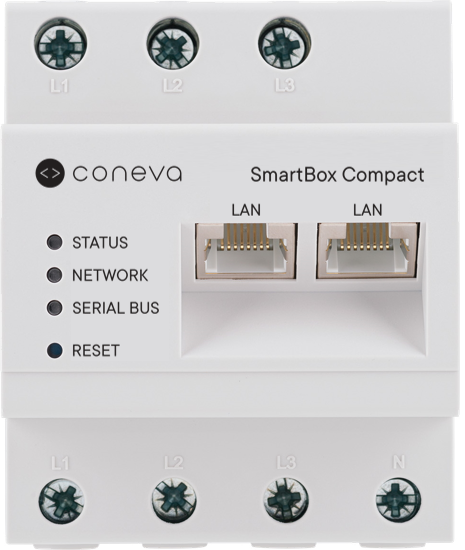2022 | E.ON UK
Smart grid solution for an energy management system within an energy community
The Project
In Maidenhill near Glasgow, a residential district with 66 houses is being newly built. All residential buildings are equipped with photovoltaic systems for green self-supply of electricity. According to the G100 requirements from the Energy Networks Association, which determines the local grid feed-in from renewable energy generation, a smart grid solution is required to manage the distribution of generated electricity and feed-in to the grid operator’s network, while maximizing the supply of self-generated PV electricity to prosumers. This energy management system must be implemented in each house in the district.The Challenge
The G100 requirements of the Energy Networks Association regulate the maximum local PV grid feed-in within a grid area. Due to the decreasing electricity production costs of renewable energies, the installed generation capacity of PV systems in low-voltage grids is steadily increasing. However, many power grids are not yet dimensioned for the increased feed-in capacity. In order to continue to enable the expansion of decentralized power generation and at the same time ensure security of supply, there are so-called “export limiting schemes”. Typically, they specify that no electricity may flow via the substation into the upstream power grid. However, prosumers can share the electricity they produce among themselves in an energy community – provided that only the lowest grid level takes up the surplus PV electricity in each case. Therefore a central smart grid solution is required that manages the entire district, including all PV systems, consumers, and the grid operator’s substation in order to avoid a power flow out of the low-voltage power grid. For this purpose, the system has to curtail each single PV system in accordance to the power flow at the substation within five seconds. A communication infrastructure must be established between the households and respective inverters of the PV systems and the substation in order to monitor and control each single site.

The Solution
With the installation of the coneva SmartBox Compact in all residential houses and the subsequent connection of the PV inverters, coneva implements the required local communication interface, which not only capture measured values, but also allows direct control access to the inverter. Subsequently, the project partners jointly set up the substation monitoring, also via a coneva SmartBox. The communication infrastructure setup allows us to remotely manage the district from our coneva IoT platform. In addition to the secure and continuous 24/7 data flow, this also provides the algorithm for live control of the networked PV systems. Now all connected inverters can be controlled depending on the current energy flow at the substation of the smart grid via the coneva IoT platform, where all data flows come together. This makes it possible to precisely control at what time which amounts of electricity is produced by the rooftop PV systems and taken up by the grid for consumption in the immediate neighborhood. The smart grid also pays attention to fairness: each of the networked PV systems supplies the same share to intelligently manage the neighborhood. This is possible because the coneva algorithm calculates and executes a pro-rata curtailment of the PV plants live.
The Result
As a service provider for decentralized energy markets, coneva provides E.ON with a platform-based technology solution for smart grids that covers everything from networking to optimization and control of prosumers within a new housing district. The fully automatized solution is available through coneva’s Azure-based IoT platform and creates value for all stakeholders.
- The local low-voltage grid is intelligently controlled, E.ON supports real estate developers in implementing renewable, decentralized supply concepts, and households enjoy maximum supply through low-cost, locally generated electricity.
- The entire smart grid solution is also scalable as required, both in terms of hardware and software.
- The technology is ready and the next project goal is that many more households will join the local electricity community.
"The UK will require hundreds of thousands of new low carbon homes to be built in the coming decades - all connected to a smart energy network. To do that we cooperate with coneva, an innovative and experienced partner that provides the solution with their self-developed software-based community services. Therefore, we will enable homes to be built to the highest sustainability standards and connected sufficiently to the grid."
Denver Rumney (U.K. Lead at E.ON Group Innovation)
"The project with E.ON fits 100 % with our vision of decentralized, regional energy markets. Here, we combine our expertise in local networking and control of prosumers with the typical challenges of the energy transition at the local grid level."
Georg Völkl (Product Manager at coneva GmbH)
SAAS SOLUTIONS FOR INTELLIGENT ENERGY MANAGEMENT
Projects and References
AKTIV & IRMA
Aktiv & Irma
Ask for your individual offer!
With just a few clicks, we can identify your potential and the available options for realisation. At once you will receive an individual offer from us.
A solution for every challenge
Every project is unique and we pride ourselves on developing precisely tailored and modular solutions for you.
coneva Charging
coneva Charging enables intelligent control of charging processes including VIP charging and PV charging.
coneva Monitoring
With the visualization of all energy flows in the company, coneva Monitoring creates a system for energy monitoring and energy controlling.
coneva Flex
Benefit from variable electricity tariffs with load shifting? With coneva Flex, we offer a system for flexibility marketing in your company.
Thank you for your inquiry!
We will get back to you as soon as possible.